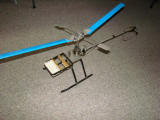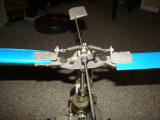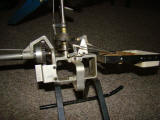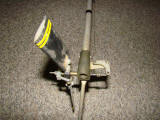Du-Bro Tristar (1975)
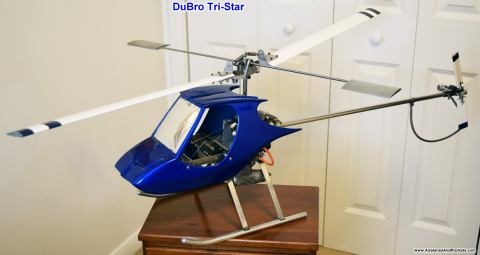 |
Specification:
|
||||||||||||||
| Documents: | |||||||||||||||
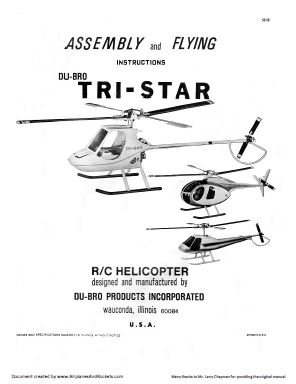 TriStar Manual |
|||||||||||||||
So named because the 'standard' mechanics came with one of three versions:
* Scorpion (based on the full-size original from Rotorway)
* Hughes 500D
* Enstrom F-28 Shark
The Tri-Star mechanics used a fixed pitch teeter rotor head rotating anti clockwise with control only by the paddles (Hiller). The rotor blades were held on with a single bolt thus allowing them to lead and lag with teeter damping achieved by by springs connected to the head assembly. The rotor blades were of a flat bottom lifting section with pitch fixed at about 8° which was the general 'norm' of the time as rotor head speeds were low due to the basic nature of the assemblies.
The paddles were broad and the paddle bar long and 4 mm thick; more suitable to a 60 helicopter of 30 years later. Unusually, the paddles also had a lifting section airfoil in an attempt to increase the overall lift of the head assembly. The paddle material was aluminium and their weight plus the dimension would have given good hovering stability; the main requirement back then when most people were tyro's.
NOTE; on the Hughes 300 page in the background of the photo with the yellow model there is a Tri-Star fitted with 'cans' on the flybar; this was an option available at the time and seemed to be an 'American' thing as it was not done anywhere else in the world. The flybar 'cans' whilst providing strong control also produced a lot of drag and were not as precise as airfoils so after a while the general trend was to remove them and convert back to paddles.
The tail end though did look very spindly having a boom of only 1/2" in diameter. The helicopter chassis was of the aluminium single plate design similar to the MM Lark with all components bolted on to it thus making it look a very thin helicopter. The tail rudder linkage consisted of a thin wire and the mechanism was spring loaded to pull back the rudder arm. In contrast to the main rotor, the tail rotor blades were rigidly fastened with double screws and for some unknown reason the blades did not rotate up into the the air flow from the main rotor but downwards away from it. This layout reduced tail rotor effectiveness both in the hover and also in forward flight however, this reduction also tended to reduce the yaw in forward flight; maybe it did work (no comment noted in any reports) especially as the helicopter was not fitted with either a vertical or horizontal fin.
The 40 size engine was started from the rear by a cone drive and power was transmitted from the engine by belt to a plastic driven gear through a clutch, which directly drove the tail rotor and then through bevelled gears to the main rotor.
Whilst the Tri-Star was not a big helicopter it was quite tall and of a similar height to something like a later Raptor 30. Despite its slender appearance it was relatively heavy; though not surprising given the construction materials.
The Tri-star was considered 'marginal' on power which was a common complaint of the 70's regarding the power, or lack of it, from the engines of the period. However, the tendency to 'have a go' at helicopters with a 'worn out' aero engine would not have contributed in no small way to that perception.
Du-Bro Tristar - Scorpion
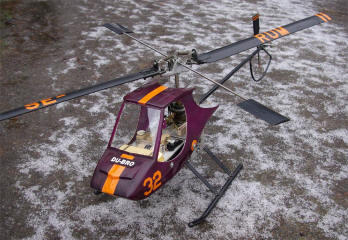 Dubro Scorpion
Dubro Scorpion 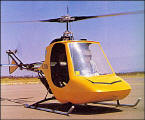 Rotorway Scorpion.
Rotorway Scorpion.
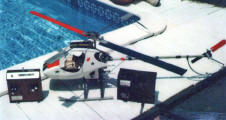
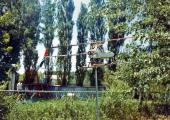
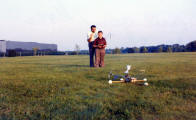
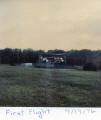
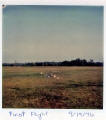 1976 - Gary Quiring from RC groups.com
1976 - Gary Quiring from RC groups.com
This goes way back. I dug up some old photos from my first heli days. I was 15 years old. I built a Heathkit Pack 17 radio and the heli was from Dubro. Yes Dubro actually made helicopters back then. They had the 40 size Tristar and the larger 60 size Shark. I will never forget what sold me on that heli, it was seeing Nick Ziroli on the front cover of Flying models hovering a Shark with pontoons on it. At that time my only RC experience was a couple of boats I built from Dumas.
Early test stand used an old shower head and a ball joint to allow the heli to move around. Colours were very patriotic, it was 1976 and bicentennial was a big event that year. Mike Pilla talking me through my first attempts to hover.
The Tristar had it's maiden flight at the Bell Labs field in Holmdel, NJ. Back then helicopters were not very well known or reliable! Luckily I found Horace Hagen who was an early pioneer in helicopters in the USA. He spent many hours with me going over all my mistakes. The Tristar was powered by an OS 40.
I never really learned how to fly that helicopter. It would constantly fall apart. But what an adventure those days were and it bit me good, I have enjoyed the hobby all these years.
Du-Bro Tristar - Hughes 500D

Du-Bro Tristar - Enstrom F-28 (Shark)
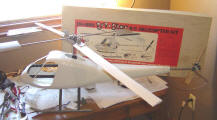
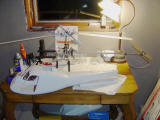
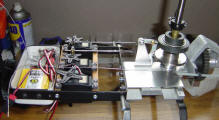
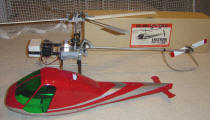
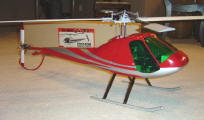
An interesting personal view regarding the Tristar is available on the Airplanes and Rockets web site at the link below;
Airplanes and Rockets - Tristar helicopter

